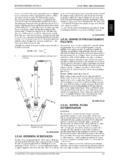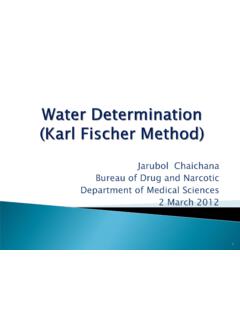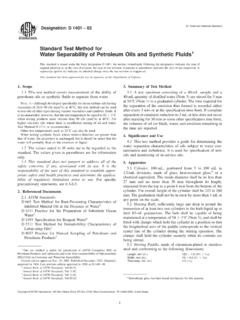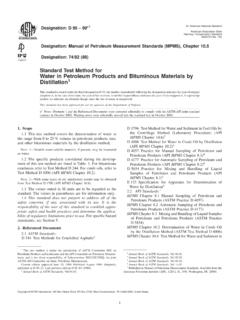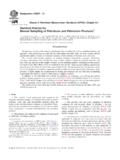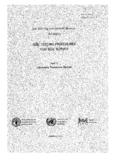Transcription of Treatment and control measures and technical achievability
1 New section for Microcystin-LR background document: Treatment and control measures and technical achievability Microcystins are largely cell-bound, with usually more than 95% of the toxin contained within healthy cells. Dying and decaying cyanobacteria may release microcystins into the water, but the data available indicate that usually biodegradation will be sufficiently effective to preclude the build-up of high concentrations of extracellular microcystin dissolved in water, unless cell lysis is induced artificially (for such a case, see Jones & Orr 1994). A very effective way to deal with high microcystin concentrations therefore is to remove the cells, intact and without damage (Drikas et al.)
2 2001; Hart et al. 1998). Any damage, such as that caused by preoxidation, may lead to cell leakage, and consequently in an increase of the dissolved toxin concentration entering the Treatment plant. This may be critical, as dissolved toxin is not removed by conventional Treatment technologies. Conventional Treatment using coagulation will remove cyanobacteria cells; however, sludge containing toxic cyanobacteria should be isolated from the Treatment process as cells contained in sludge can break down rapidly and release dissolved toxin (Chow et al. 1999). Experimental and full-scale studies for the removal of cyanobacteria using membranes are scarce. In general, micro- and ultra-filtration membranes could be expected to remove cyanobacterial cells effectively.
3 Membrane filtration of toxic cyanobacteria should be carried out with frequent backwashing, and isolation of the backwash water from the plant due to the risk of the cells releasing dissolved toxin (Chow et al. 1997; Gijsbertsen-Abrahamse et al. 2006). The treatments mentioned above will not remove extracellular, or dissolved toxin to a significant extent. Most of the common microcystin variants are well removed by activated carbon (Hart et al 1998; UKWIR 1996; Cook and Newcombe 2002). The exception is microcystin LA which is not readily removed and other processes are recommended (Cook and Newcombe 2002). For other microcystins wood-based, chemically activated carbon is the most effective, or a carbon with similar physical properties.
4 Doses of powdered activated carbon required for removal to below the guideline value will depend on water quality, and site specific tests are recommended. Granular activated carbon filtration displays a limited lifetime for all toxins. This can vary between 2 months to more than one year depending on the type of toxin and the water quality (Newcombe 2002; UKWIR, 1996) Dissolved microcystins have been shown to be removed by some reverse osmosis and nanofiltration membranes. As removal will depend of membrane pore size distribution and water quality, site specific tests are recommended (Smith et al 2002; Gijsbertsen-Abrahamse et al. 2006; Muntisov and Trimboli 1996; Neumann and Weckesser 1998).
5 Chlorination and ozonation are effective for the removal of microcystins. A residual of at least mg L-1 of ozone for 5 minutes will be sufficient for all of the most common microcystins. For chlorine a dose of 3 mg L-1 applied to obtain a residual of mg L-1 for at least 30 minutes will be effective (Nicholson et al. 1994; Newcombe 2002; Rositano et al. 1998: Rositano et al. 2001; Ho et al. 2006a; Acero et al. 2005). Microcystin LA may require a higher residual, as it is slightly less susceptible to oxidation by chlorine (Ho et al. 2006). Potassium permanganate is effective for microcystins, and chlorine dioxide and chloramine are ineffective (Rositano et al. 1998).
6 Riverbank filtration and slow sand filtration have proven very effective in removing microcystins, as cyanobacterial cells are retained and dissolved toxin is degraded in the uppermost substrate layers. Gr tzmacher et al. (2006) show that a travel time of several days is likely to suffice, particularly if the underground consists of fine- to middle-grained sand and conditions are aerobic, not below 10 C, and some clogging layer ( biofilm) is present. Biological filtration can be very effective for the removal of most toxins. However, factors affecting the removal such as biofilm mass and composition, acclimation periods, temperature and water quality cannot be easily controlled (Ho et al.)
7 , 2006b). References Acero J., Rodriguez E. and Meriluoto J (2005) Kinetics of reactions between chlorine and the cyanobacterial toxins microcystins. Water Research, 39, 1628-1638. Chow, C. W. K., Drikas, M., House, J., Burch, M. D. and Velzeboer, R. M. A. (1999) The impact of conventional water Treatment processes on cells of the cyanobacterium Microcystis aeruginosa. Water Research 33(15), 3253-3262. Chow, C. W. K., Panglisch, S., House, J., Drikas, M., Burch, M. D. and Gimbel, R. (1997) A study of membrane filtration for the removal of cyanobacterial cells. Journal of Water SRT Aqua 46(6), 324-334. Cook, D. and Newcombe, G. (2002) Removal of microcystin variants with powdered activated carbon.
8 Water Science & Technology: Water Supply 2(5/6), 201-207. Drikas, M., Chow, C. W. K., House, J. and Burch, M. D. (2001) Using coagulation, flocculation and settling to remove toxic cyanobacteria. Journal of the American Water Works Association 93(2), 100-111. Hart, J., Fawell, J. K. and Croll, B. (1998) The fate of both intra- and extracellular toxins during drinking water Treatment . Water Supply 16(1/2), 611-616. Ho L, Onstad G, von Gunten U, Rinck-Pfeiffer S, Craig K and Newcombe G (2006a) Differences in the chlorine reactivity of four microcystin analogues. Water Research 40 (6): 1200-1209. Ho L, Meyn T, Keegan A, Hoefel D, Brookes J, Saint CP and Newcombe G (2006b) Bacterial degradation of microcystin toxins within a biologically active sand filter.
9 Water Research 40 (4): 768-774. Newcombe, G. (2002) Removal of algal toxins from drinking water using ozone and GAC. AWWA Research Foundation Report, American Water Works Association, Denver, CO. Gijsbertsen-Abrahamse AJ, Schmidt W, Chorus I, Heijman SGJ. (2006) Removal of cyanotoxins by ultrafiltration and nanofiltration Journal of Membrane Science 276 (1-2), 252-259 Gr tzmacher, G., Wessel, G., Bartel, H. & Chorus, I. (2006): Final report NASRI : Retention and elimination of cyanobacterial toxins (microcystins) through artificial recharge and bank filtration. KompetenzZentrum Wasser Berlin. Muntisov, M. and Trimboli, P. (1996) Removal of algal toxins using membrane technology.
10 Water Journal of the Australian Water Association 23(3), 34. Neumann, U. and Weckesser, J. (1998) Elimination of microcystin peptide toxins from water by reverse osmosis. Environmental Toxicology and Water Quality 13, 143-148. Nicholson, B. C., Rositano, J. and Burch, M. D. (1994) Destruction of cyanobacterial peptide hepatotoxins by chlorine and chloramine. Water Research 28(6), 1297-1303. Rositano, J., Nicholson, B. C. and Pieronne, P. (1998) Destruction of cyanobacterial toxins by ozone. Ozone: Science & Engineering 20, 223-238. Rositano, J., Newcombe, G., Nicholson, B. and Sztajnbok, P. (2001) Ozonation of NOM and algal toxins in four treated waters. Water Research 35(1), 23-32. Smith, D.











